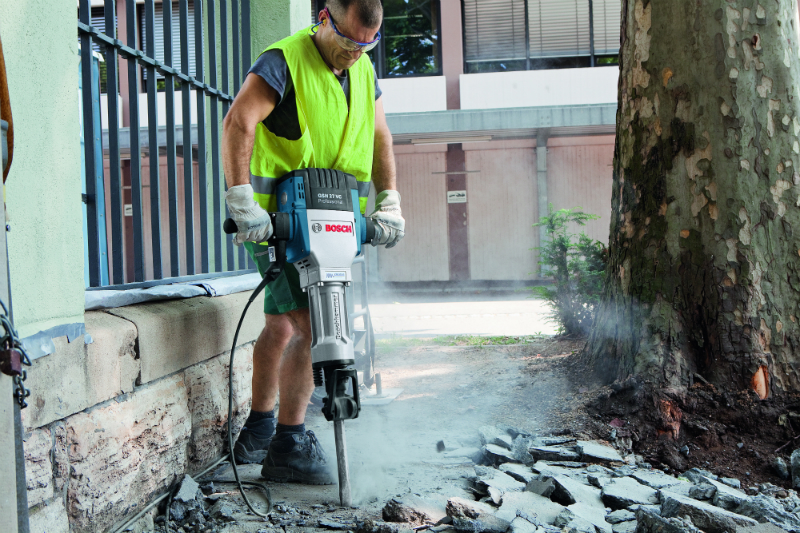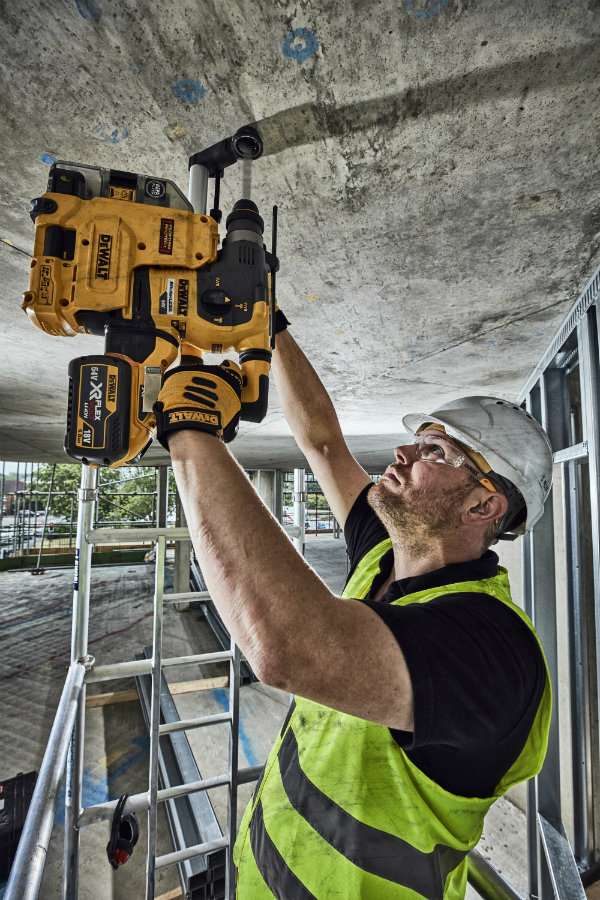
Hammers & Breakers buying guide
Hammers & Breakers: The 30-Second Buying Guide
| Brand | Model | Type | Price |
|---|---|---|---|
| MAKITA | DHR242Z | SDS+ hammer | £170 |
| MAKITA | HR2630 | SDS+ hammer | £131 |
| MAKITA | DHR202Z | SDS+ hammer | £124 |
| MAKITA | HR2630X7 | SDS+ hammer | £133 |
| BOSCH | GBH 2-26 | SDS+ hammer | £131 |
| BOSCH | GBH 2-26F | SDS+ hammer | £174 |
| BOSCH | GBH 2-28 DV | SDS+ hammer | £210 |
Things to consider when buying a hammer or breaker:
- Power – Do you want a cordless option for greater manoeuvrability or corded for constant use (110v for work sites or 240v for home)?
- Wattage – Higher wattage gives more power to drill wider holes into harder material
- Vibration – What is the vibration rating? A lower figure means the tool can be used for a longer period of time.
- Weight – Heavier weight gives greater pressure onto the drill bit.
- Function – Do you need a rotary action or do you need a chisel function also?
Drill use by type:
| Drill category | Cordless option available? | Drilling into concrete | Drilling into masonry | Can chisel away concrete and tiles | Can be used for breaking concrete |
| SDS+ 2 function hammer drill | ✔ | ✔ | ✔ | ||
| SDS+ 3 function hammer drill | ✔ | ✔ | ✔ | ✔ | ✔ |
| SDS-MAX 2 function hammer drill | ✔ | ✔ | ✔ | ✔ | ✔ |
| Breakers | ✔ | ✔ |
Hammers & Breakers: A Breakdown of their uses
Key uses for Hammers & breakers
There are three key uses for Hammers or Breakers;
- Drilling: Hammer drills are used when a standard drill just isn't powerful enough. They have an aggressive hammer action which means they can drill into very hard material. They can also be used to drill much larger holes than conventional combi drills.
- Chipping: Chipping can be undertaken by some drills. This function will enable the drill to have a chisel inserted and used without a rotary action. This can be especially useful for removing tiles or channelling out walls for recessed wires etc.
- Breaking: Breaking is similar to chipping but is usually assigned to much larger machines as they will demolish large areas rather than being selective.
Key Considerations When Buying A Hammer drill or Breaker
Some of the key considerations when looking to purchase a hammer or breaker are:
 Chuck type: Hammers and breakers will come with an SDS+, SDS-Max or a Hex chuck. SDS+ is generally used on the smaller machines (around 2kg to 5kg). The chucks are designed so that the bits lock into position and will not slip even when under high pressure. SDS MAX is used on larger machines as it has a bigger tool holder so can withstand much more force being applied. The HEX bits are used on the largest breakers and will only be available as points or chisels in various sizes. If you already have chisels, points or drill bits it is important that you select the correct chuck type.
Chuck type: Hammers and breakers will come with an SDS+, SDS-Max or a Hex chuck. SDS+ is generally used on the smaller machines (around 2kg to 5kg). The chucks are designed so that the bits lock into position and will not slip even when under high pressure. SDS MAX is used on larger machines as it has a bigger tool holder so can withstand much more force being applied. The HEX bits are used on the largest breakers and will only be available as points or chisels in various sizes. If you already have chisels, points or drill bits it is important that you select the correct chuck type.
Function: Hammers and Breakers are available with various functions.
Breakers, also known as Demolition hammers or Jack hammers, will generally just have a chiselling function and nothing else.
SDS+ drills, also known as rotary hammers, are available as a 2 function hammers or 3 function hammers. 2 function hammers have a rotary only mode, and a rotary with hammer mode. 3 function hammers also include a 'hammer only' (no rotation) mode.
SDS-Max drills, also known as rotary hammers are available as a single function 'hammer only' (No rotation) or a 2 function rotation hammer and hammer only.
The needs of the user obviously determine which one is required. The 3 function drill give the greatest variety but they aren't designed to be used solely for chiselling. If you need to chisel only then a breaker is always best. Some drills will also come with the option of a 'quick change chuck' which enables the use of a 13mm keyless chuck on the drill.
Power: The power of rotary hammers and breakers is usually measured in Joules (such as 4J for the smaller tools to 62J for the breakers). This refers to how much force the drill hits with. The higher the joules, the higher the force.
Wattage: The wattage of machines will give a good indication as to how powerful the motor is. Some of the smaller motors will be perfect for drilling a lot of holes into concrete but they can be limited in the diameter drill bit that can be used.
Vibration: Vibration is a key factor as hammers and breakers do have a high vibration due to the mechanism inside. Many have been developed with anti vibration features so that they can be used for longer lengths of time. The vibration is measured in m/s2. The HSE website provides guidance to working out how long a tool can be safely used. Click here for the HSE 'Vibration at work' website
Weight: Hammers and breakers are available in a variety of weights, ranging from around 2kg up to 30kg. The smaller size hammers are ideal if you need portability and are using them for a longer length of time but they are limited in their capabilities. The larger hammers and breakers are particularly good for breaking large or dense areas with a lot less effort. The added weight will enhance the breaking capacity for any user.
Power source: SDS+ and SDS-Max Hammers are available in cordless or corded options. the cordless drills are very powerful and, with the introduction of higher power batteries, can be up to 10kg in weight. They are equal to their corded counterparts in terms of power and sometimes will perform better. This enables greater areas of use and manoeuvrability. The only thing that needs to be considered is the battery life. Most will last a long time but if it is required for constant use all day then a corded option would be preferable. Currently, breakers are only available as corded machines due to the power they would require from a battery.
Accessories: Some machines will come with accessories included in the case. However, this not always standard so make sure that you have the correct accessories for the job you need to undertake.
Hammer and Breaker Safety
Hammers and Breakers are very powerful machines and can create a lot of hazards so the following safety tips should always be considered:
Ensure the device is switched off before you plug it in. Before plugging a hammer or breaker into the power source, make sure that the machine itself is switched off.
Read the manual and understand how it works. Even for an experienced user, when getting a new power tool it is always a good idea to read the manual to ensure that you are completely familiar with the modes of operation and the features of the tool. Power tools are inherently dangerous machines, so this is very important to both help prevent injury & damage to the machine.
Wear the right clothing and protective gear. It is always a good idea to protect yourself by wearing the appropriate safety gear when using a hammer drill or breaker. They can regularly throw up debris. For this reason, it is essential to wear safety goggles. It is also a good idea to wear safety, or anti-vibration, gloves. Depending on the circumstances and ventilation, it can be a good idea to wear a dust mask as they can generate a lot of dust. The larger machines in particular can also be quite noisy, so ear defenders are recommended.
Check the vibration rating. Hammers and Breakers can generate a lot of vibration and this can be very damaging to your health. Make sure you check the HSE website and stay within the time limits listed for your machine. Click here for the HSE 'Vibration at work' website
Choosing Hammer and Breaker bits
Points: Points are used for breaking up large areas of concrete into smaller bits so that it can be removed easily.
Chisels: Chisels are usually used for concrete or tiles to remove a surface layer without demolishing everything underneath that layer.
Drill bits: These are generally only available in SDS+ and SDS Max fittings. They are primarily for drilling into concrete but you can also get drill bits that will drill through rebar and reinforced concrete.
View our range of Hammers and Breakers and find the lowest prices online at Howe Tools.

